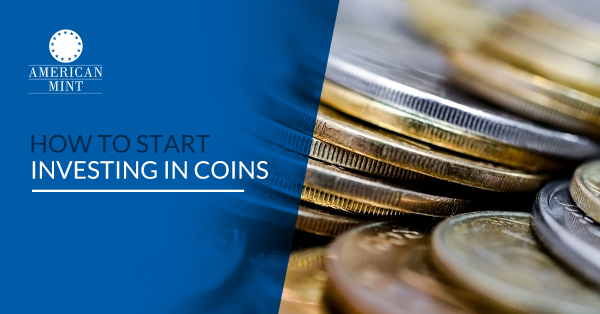Are you interested in the fascinating world of collectible coins and precious metals? If so, you’re in good company. The world is full of collectors, enthusiasts, and individuals like you who are passionate about the intricacies and details of coin collecting.
However, it's natural to feel confused about how to start out. The art and science of coins and coin collecting has a long and rich history, so the enormous amount of information and details can seem overwhelming at first.
If you know you’re ready to take your first steps into the world of coin collecting, but aren’t sure where to start, you’re in the right place. In this article, we’ll cover some of the basics, like standard terminology and concepts, as well as what type of gold and silver coins to invest in.
What Are Precious Metals?
Any discussion of coin collecting should begin with an explanation of what precious metals are. This term might immediately bring to mind metals like gold and silver, and while these fit the bill, they aren't the only metals considered precious. Before we introduce the precious metals that coins are usually made from, it’s important to understand what makes these metals precious in the first place.
A simple definition might read like this: a precious metal is a naturally-occurring metal that is reasonably rare and more difficult to come by than other more common metals. Because these metals are hard to find, the demand for them outweighs the supply, so they have a high economic value. Even today, these materials are still sought for their use in the worlds of art, jewelry, technology, and investment.
Precious metals are further set apart by their physical properties. Aside from being highly lustrous and durable, they tend to be less reactive than base metals as well, so they are harder to damage with chemical reactions. In addition to their rarity, the natural beauty and luster of these metals makes them highly desirable in a variety of industries and practices, and allows them to command a higher price.
Investing in Rare Coins

The most well-known and popular precious metals are as follows:
1. Gold
Gold is most likely the first metal that comes to mind upon hearing “precious metal.” It has been highly prized throughout history and remains so today. Gold has also been a standard form of currency for thousands of years, in many cultures around the world. Gold is currently being mined at an unsustainable rate, meaning supplies will eventually run out. This puts gold currency in premium demand, and drives the price even higher.
2. Silver
Historically, gold might be the most prized metal, but silver is a close competitor. Silver has consistently commanded a high price throughout history, thanks in part to its natural beauty and luster, as well as its usefulness in a wide range of applications. Traditionally, cultures around the world have used this precious metal for both currency and decoration. Today, silver continues to be used for in coin and jewelry, while also finding new uses in technology, medicine, and electronics. Thus, silver is consistently in high demand.
3. Palladium
Unlike gold and silver, palladium doesn’t have an extensive history of use and production. This is in part due to the fact that palladium was only discovered in 1802, so its place within human culture is still being defined. Nonetheless, palladium is extremely rare, and costly to mine, making it quite valuable for its uses in the automotive, medical, and electronics industries, as well as in currency production.
4. Platinum
Platinum is recognized today as one of the most valuable of all precious metals. This high value is mostly due to platinum’s extreme rarity, and only small amounts are mined each year. Today, platinum is primarily used in the medical, electronics, jewelry, and automotive industries, where its anti-corrosive nature makes it uniquely suited for many different applications.
Investing in Rare Coins

Now that you have a basic understanding of precious metals, let's move forward and discuss which coins are worth investing in, and why these coins are worth so much in the first place.
Value in coinage typically comes from a combination of three sources, and as such, it can vary widely. While there will be some exceptions where a coin is valuable for an outlying reason, most coins’ values come from a combination of:
• Metal Content:Precious metals are typically worth quite a bit of money. Even if the coin doesn't contain a high percentage of the metal in question, the small amount it does contain can still drive the overall value of the coin up. Usually, the more precious metal a coin contains, the higher its value will be. As a collector, it is always good to know the per ounce price of precious metals on the market.
• Rarity: In most cases, rarity plays a far more important role in determining a coin’s value than its material composition. It should go without saying that the rarer a coin is, the more valuable it will be. For example, if only 100 copies of a certain coin were ever produced, these coins will nearly always be more valuable than a coin that is one of 10,000 copies, even if this second coin has a higher gold content than the first.
• Condition: A coin’s value is also partially determined by the condition of the coin, with more damaged coins commanding a lower value than coins in better shape. With few exceptions, this is a relatively universal rule. That being said, the value of a coin is still primarily a measure of its rarity.
Based on these three different metrics, we can easily begin to see how some coins can be worth more than others. Based on what we’ve discussed, the best coins to invest in will have high precious metal content, exceptional rarity, and be in good condition. On the other hand, a coin that is made only of base metals, is one of many copies, and is in poor condition will usually not be worth your time or money.
Understanding Bullion Coins

As you enter the world of coin collecting and investing, a term you'll begin to hear quite often is "bullion" or "bullion coin." But what is a bullion coin? Let’s take a moment to explain what this term means and how it affects you as a collector and investor.
The world “bullion” refers to a lump quantity of precious metal that is 100% pure or nearly pure. Many people choose to purchase bullion and then wait until the market is in their favor to sell it at a profit. You can buy any precious metal in bullion form, and bullion is usually produced as an ingot, a bar, a round, or a coin.
Bullion coins may look very similar to the ordinary coins that pass through your hands at cash registers, but they're often quite different.Bullion coins are not official currency, so you would never use them in day-to-day transactions or shopping. Instead, bullion coins are often bought directly from the government or private institutions. Many investors then wait for the right moment to sell them, or even to pass them onto their heirs. While the value of an ordinary coin is affected by its composition, rarity, and condition, a bullion coin's value comes entirely from its precious metal composition.
Many series of government-issued bullion coins will have unique designs that mark them as members of the same series. The American Buffalo, the American Eagle, and the Canadian Gold Maple Leaf are well-known examples of some of the most popular bullion coins on the market today.
Because the value of a bullion coin is so closely tied to the current price of gold or silver, which is constantly fluctuating, these coins are generally not ideal for long-term investment. Instead, they might make good choices for short-term investment and should typically be liquidated quickly, before the market value drops.
What Is Coin Grading?

Coin grading is one of the most important concepts to know and understand when collecting rare and valuable coins. Coin grading systems help classify and determine a coin's condition, which helps dealers and buyers alike assign a fair value to the coin, and sell it at a fair price.
When it comes to coins, condition is subjective. What one person views as a coin in “good condition” might seem like “poor condition” to another person. To help keep things consistent and standard, experts have introduced the now universally-accepted coin grading scale.
The coin grading system uses a 70-point scale, with low numbers representing the most damaged coins and high numbers representing the most pristine. Every time an expert grades a coin, they assign it a point value somewhere on this scale. The 70-point scale is split into specific grades, with labels that serve as a shorthand for a coin’s condition. For example, a coin graded at a 6 out of 70 would fall into the “good” category, while a coin graded at a 45 out of 70 would be called “extremely fine.”
The entire list of point values and their corresponding grades is as follows:
• 1: Poor (P)
• 2: Fair (F)
• 3: Almost Good (AG)
• 4, 6: Good (G)
• 8, 10: Very Good (VG)
• 12, 15: Fine (F)
• 20, 25, 30, 35: Very Fine (VF)
• 40, 45: Extremely Fine (XF or EF)
• 50, 53, 55, 58: Almost Uncirculated (AU)
• 60-64: Mint State Uncirculated (MS Uncirculated)
• 65, 68, 69: Mint State Choice Uncirculated (MS Choice)
• 70: Mint State Perfect (MS Perfect)
Coins are usually listed with both the numerical grade, and letter-based grade category. For example, a coin in Very Fine condition might be assigned a grade of VF-30. A coin in perfect, mint-state condition, would be assigned a grade of MS-70.
While anyone can look at a coin and assign it an unofficial grade, the grade will not carry any actual weight unless it comes from one of the two certified organizations that provide official grading. The Professional Coin Grading Service (PCGS) and the Numismatic Guaranty Corporation (NGC) are the most widely respected coin grading services, and their designations are universally accepted. Dealers will often note when a coin has been graded by the PCGS or the NGC, in which case, you can feel confident that the grade is accurate and fair.

A typical grading process consists of these four steps:
• A certified grader examines the coin carefully and either verifies that it is genuine, or dismisses it as an imitation.
• Assuming the coin is genuine; the grader next verifies that the coin has not been tampered with in an attempt to raise the coin’s value.
• The grader takes note of the coin’s characteristics and compares them against the traits recorded for other coins made in the same year and mint, noting things like the design and production qualities.
• Lastly, the grader examines the coin’s condition, looking for things like wear, damage, and loss of luster.
Once the grader has completed all of these steps, the coin receives a grade, which will play a large role in determining the coin’s price and value.
What Is a Proof Coin?

Another potentially confusing term that crops up frequently in coin-collecting is “proof coin.” Proof coins, in short, are premium versions of normal, everyday, legal tender coins.
These normal, everyday coins are referred to as “business strike” coins, and describe most coins you would see in everyday life. These are regular coins that pass through your hands, your cashier’s hands, as well as your wallet and banks.
Proof coins are different because they are intended for collectors and investors, and never enter circulation. Mints strike these coins using the same process as their standard business strike coins, but with an additional special die preparation technique that enhances the shine of the finished coin. Once they’re struck, collectors prize them highly and keep them out of general circulation.
What’s the Difference Between Proof and Uncirculated Coins?
Based on the term “uncirculated” alone, it might be easy to assume an uncirculated coin is the same thing as a proof coin, as we just discussed. This is not true, however; “uncirculated coins” are not produced with the same special die preparation technique that defines “proof” coins.
The term “uncirculated coin” refers to an ordinary business strike coin that has never entered circulation, so it is still in the perfect mint condition in which it was created. When a coin is still in this perfect condition, the technical grader’s designation is “Mint State.” A Mint State coin might receive a grade of MS-60 at the low end, or MS-70, which is the very highest grade a business strike coin can receive. This grade designates a coin that is utterly free from blemishes of any kind, while still retaining all its original luster and shine.
How to Understand the Spot Price of Gold

Before you can begin responsibly investing in precious metals, there’s one more major idea to understand, and that’s the market price of gold.
The price of precious metals is based on two crucial factors: supply and demand. If there is a large supply and a small demand, the price goes down. If there is a small, limited supply, and a lot of demand, than the reverse is true, and prices will go up. Since both the supply and demand are in constant fluctuation, the prices of precious metals are always changing.
Because of these fluctuating prices, the idea of spot pricing is a key concept to understand when buying gold or any other precious metal. The spot price of gold refers to the exact current price that gold is selling for in a particular location, on a particular day, and at the specific moment you are seeing the price. In other words, it’s the price at only the exact time and place you happen to be. This spot price may be different if you wait an hour, and it may be different in another city at the same exact moment. In other words, it’s the price of gold based on checking the markets “on the spot”.
Because of the nature of spot pricing, a smart way to buy and sell precious metals is to buy at a low spot price, and then resell when and the spot price is higher, thus making you money in the process.
When it comes to buying gold and silver coins for investment, there are generally three options. You can either buy and then resell quickly to make a quick, short-term profit, or you can buy with the intention of investing, and potentially create long-term savings. Alternatively, many collect coins simply to build their collection up, or purely for the enjoyment.
How to Choose Gold and Silver Coins to Purchase
To get started in purchasing gold and silver coins, you'll want to decide which types you want to purchase — bullion, proof, or business strike, for instance. The coin collecting community often hosts coin shows and other events that may be in your area. Learn more about the community, and talk to others who have experience in purchasing rare coins, as well as gold and silver coins. The best way to learn about buying gold and silver coins for investment is simply to get involved, ask questions, and learn as you go.
Browse Our Coin Selection Today

If you think you’re ready to begin buying rare coins online, then we invite you to browse our selection here at American Mint. We offer an impressive range of rare collectible coins in gold, silver, and platinum as well as bullion coins. We offer all these high-quality products at reasonable prices, and we make it our priority to provide the very highest level of customer service along every step of the way. And if you aren't satisfied with your purchase for any reason, we offer a money-back guarantee within 20 days of receipt.
Browse our selection of gold coins and silver coins to get started with your investing journey.
Sources:
1.https://www.americanmint.com/gold-coins
2.https://smallbusiness.chron.com/list-tradeable-precious-metals-66824.html
3.https://www.angelo.edu/faculty/kboudrea/periodic/trans_transition.htm
4.https://catalog.usmint.gov/coin-programs/bullion-coins.html
5.https://www.pcgs.com/whatiscoingrading
6.https://www.ngccoin.com/coin-grading/grading-scale/
9.https://marketbusinessnews.com/financial-glossary/spot-price-definition-meaning/







